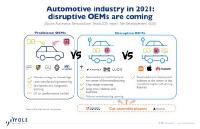
The semiconductor value in a car will reach $78.5 billion in 2026, with a 14.75% CAGR 2020-2026. A car has today, on average, $450 worth of semiconductors. In 2026, it will be $700.
Future V2X communication platforms for 5G implementation are being designed today, and products are expected for 2024 with initial products are starting to appear with dual-4G and forward-compatible 5G capabilities.
ADAS: Radars and cameras are the main sensors used by OEMs as they perform quite well and are relatively cheap. For a few years, LiDAR sensors have been slowly entering the automotive industry to provide more automated driving functions.
New habits related to cars are emerging and Gen Y now desire connectivity, convenience and the possibility to choose from different range of transportation from A to B. They are shaping an industry in which in-demand car service providers are growing.
OEMs have announced their electrification investment plans for the next 5 years which exceed $250 billion worldwide. The timeline for automotive electrification is very aggressive, as in 15 years OEMs will have to develop an entire car portfolio that will be fully electric.
Supply chain management will change due to them chips shortage, an increasing semiconductor content and electrification. OEM s have to negotiate directly with chip manufacturers, learn from the consumer industry and keep “buffer stock”.
Traditional OEMs (Audi, Hyundai, etc…) are facing disruptive OEMs (Tesla, Apple…). China is intensifying the competition and invests massively in semiconductors and in the automotive industry.
Looking at the C.A.S.E. components:
Connectivity will grow : from almost $33 billion in 2020 to almost $55 billion in 2026, with 14.55% CAGR2020-2026
ADAS will reach more than $60 billion in 2026 with 6.50% CAGR2020-2026
Sharing will reach about $3 billion in 2026 with 10.39% CAGR2020-2026
Electrification will reach $28,804 million in 2026, with 53.45% CAGR2020-2026
All adding up to a 2035 market for C.A.S.E. worth $318 billion.
Semiconductor wafer shipments will grow from 20 million to more than 45 million, with 8’’ being the most used wafer size.
The 20nm node and below will be driven by ADAS and infotainment applications.
“Today, most of the wafer production for automotive is for 130/180 nm and more, and leading-edge technology is very scarce,” says Yole’s Eric Mounier, “but 40nm and 28nm are used for the Mobileye EyeQ3 and EyeQ4 for ADAS and autonomy. Memory for infotainment and ADAS use 10-14 nm. In the future, 7nm could be used for ADAS. The current chip shortage mainly affects nodes in the 40-180nm range”.
The development of electric vehicles and self-driving technologies naturally attracts OEMs and Tier-1 component suppliers. Therefore, new OEMs like Nio, Xpeng, and Lucid Motors, among others, have recently entered the industry.
Other players coming from the semiconductor or the consumer industries will enter the field as well.
In this race to full autonomy, large OEMs with many resources – like Volkswagen – will develop the necessary software by themselves or partner with or acquire robotic vehicle companies.
Generalist OEMs with few resources are expected to rely on Tier-1s to develop basic automated driving features.
These Tier-1s will have to master camera, radar, LiDAR sensors, and the computing. According to Pierrick Boulay, Technology & Market Analyst, Solid-state Lighting at Yole: “Companies from the semiconductor side, like Qualcomm, Nvidia, and Intel-Mobileye, are positioning themselves, sometimes through acquisitions, at the center of automated driving systems.
For example, Qualcomm is in talk to acquire Veoneer to reinforce its position in the automotive industry”. Companies coming from the consumer industry, like Apple, Huawei, or Xiaomi, are also entering the market.
Depending on their strategy, they could develop only the self-driving part or the entire electric car, like Huawei is doing.
Foxconn is partnering with several companies such as Apple and Stellantis and is increasing its automotive-related business.
This new role of subcontractor, like Foxconn, is growing, and a recent partnership between Fisker and Magna showed that Magna will assemble the car. In the future, it could be possible to see new automotive OEMs being fabless and relying on the experience of subcontractors.
The COVID-19 crisis has emphasized the increasing importance of semiconductors in cars. Companies coming from the semiconductor and software sides have strong financial power and could acquire some Tier-1s or Tier-2s’ companies. This could reshape the automotive landscape in the coming years
"chips" - Google News
September 20, 2021 at 12:20PM
https://ift.tt/3CsHhUt
Chips are changing the car market, says Yole - Electronics Weekly
"chips" - Google News
https://ift.tt/2RGyUAH
https://ift.tt/3feFffJ
Bagikan Berita Ini















0 Response to "Chips are changing the car market, says Yole - Electronics Weekly"
Post a Comment